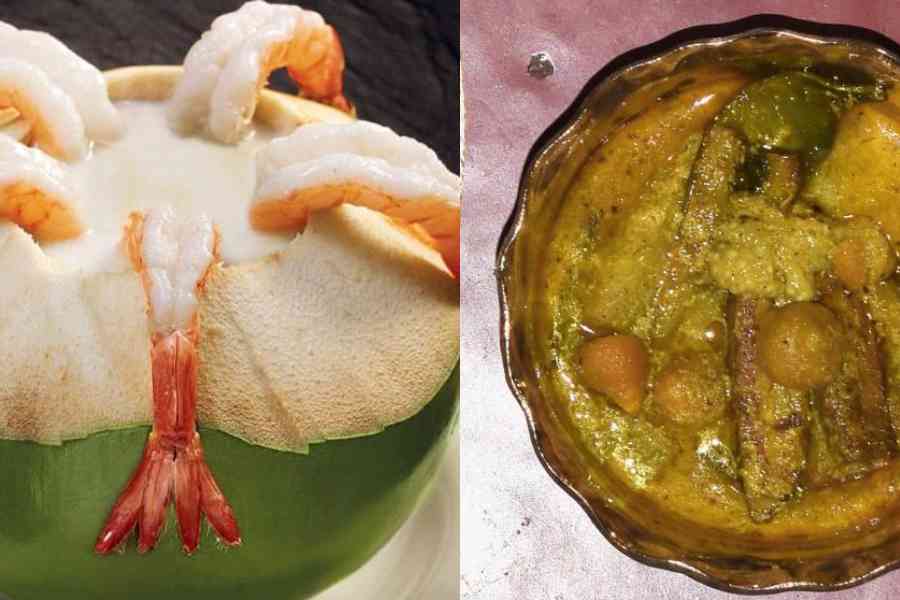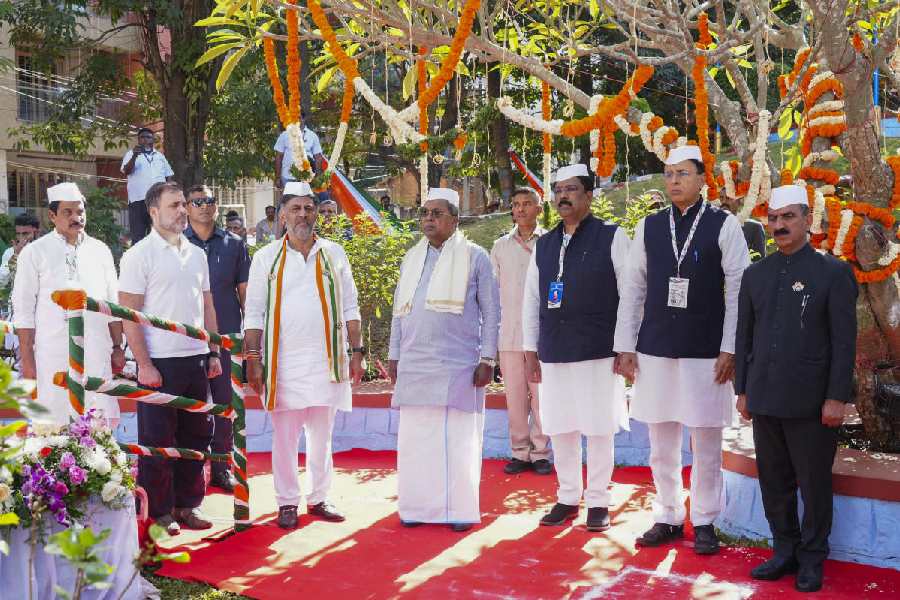A long time ago, Prawn Malai Curry became the symbol of a delicious movement. With beautifully arranged prawns cocooned in a spiced coconut broth, the dish was the culinary equivalent of a Miss World, modelling for Oh! Calcutta.
Today, Prawn Malai Curry has been declared as one of the world’s Top 50 seafood delicacies by an online travel and food guide, Taste Atlas. “Taste, at last!” someone wryly commented. I know the honour is off by a few decades, but better late than never! Though not as ubiquitous as Tandoori Chicken or dosa, Calcutta’s soul food has stirred something deep across the globe.
Back in the 1990s, when we carried Calcutta’s Bengali flavours to Mumbai, doubts swept us back to the drawing board — countless times. “Kosha Mangsho and fine dining? It is a punishment. No finger-licking? No fist-dripping? No, thank you.” Or words to that effect. If anyone had suggested that Londoners would enjoy a Bengali fine-dining experience in London one day, they would have been roundly sneered at.
Yet, dedicated Bengali cuisine restaurants like Bhojohori Manna today serve traditional Bengali delicacies to an ever-growing clientele in other cities. And our London outlet of Chourangi is unravelling the mysteries of Shukto and Ilish for Londoners — much like my father had done, albeit, at a family dinner.
My father unintentionally set the ball rolling. He had never dreamt that his words would spark off a restaurateur in me. Well, as they say, whatever will be, will be. He was a scientist for the Indian government, but more than that, he was a gracious Bengali host. My father warmly invited any international visitor at work to our home for a traditional Bengali dinner.
Now, he had unflinching faith in the food he was raised on, as well as in my mother’s culinary abilities. I had less confidence though — I always winced with a sense of alarm when the Shukto arrived before an unsuspecting foreign guest. The bitter-sweet vegetable stew was a diplomatic landmine but did this discourage my father from plunging into an intellectual discussion on Shukto? No.
He informed his guests how each do-good vegetable had calming and cooling properties; he conjured up the vision of Ayurveda and the soundness of starting a large meal with something bitter. Then, he elaborated on the creativity of layering different flavours.
I heard open-mouthed as he compared the complexities of Shukto to that of a French perfume — sautéed bitter gourds, raw bananas, flat beans, soft sweet potatoes and crispy lentil dumplings, all tempered with five spices; middle notes of ginger and finishing notes of clarified butter and milk. All perfectly timed, like a musical symphony.
That is how, he explained, the vegetables do not overpower each other while each one is cooked to perfection. I stared down at my plate with the same awe as our honourable guest from another country.
That was my father’s doing. He made me realise that cooking is an immense responsibility — of not just getting the flavours right, but also preserving the stories they tell. Don’t we owe it to our future? Each preparation on the table is an album book full of memories — some connecting the long-distant past with our present.
Shorshe Ilish, another nuanced delicacy, is an emotional journey for every Bengali; as the Ilish migrates upriver from the sea to the Ganga and Padma, Bengalis of Calcutta travel back emotionally to their villages and rivers.
This was the strength of my father’s culinarian spirit — our very foreign guests ditched the fork and started using their fingers to separate the fish from the bones.
Once again, I could foresee screaming headlines: “Foreign representative chokes on a fish bone.” Thought of the ensuing diplomatic kerfuffle made me swallow a whole Beguni in one gulp, whereas my father could only see the bridging of minds through the senses of taste, touch, smell and sight.
It was then that I realised how little we all differ as humans. It might have delayed my attack on the Kosha Mangsho by a nanosecond. Yet, in that nanosecond, my respect for Calcutta’s Bengali food deepened.
Ernest Hemingway had described an encounter with Paris as “Moveable Feast”, referring to the sensorial city that stays with us, long after we leave. If any other city is a multi-sensorial feast that changes us from within, then it is Calcutta.
My father’s deep conviction about our tastes and stories egged me on with the foolhardy experiment named Oh! Calcutta. We were not just serving Calcutta’s Bengali food to the world, but an intangible bond, our identity that can’t be removed from this city without losing its essence.
Which way would it turn? There was only one way to find out. And that was to put our heart and soul into the favourite dishes of Calcutta’s people, into the treasured recipes of our mothers and grandmothers, and let the world be the final judge.
I am proud to say that, for 30-odd years, Calcutta’s flavours are singing on the taste buds in other cities — Delhi, Mumbai, Bangalore, London and, soon, New York. So, carry on Malai Curry. You make me hungrier for Calcutta.
Anjan Chatterjee is the chairman and managing director of Speciality Restaurants, which has several brands including Mainland China, Oh! Calcutta, Sigree, Haka, Machaan, Mostly Kababs, Just Biryani and Sweet Bengal











